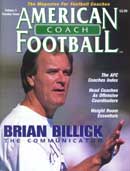Article CategoriesAFM Magazine
|
Re-Examining SpearingThe incidence of cervical spine injury hides the risks.by: Jon Heck Coordinator of Athletic Training Richard Stockton College © More from this issue Every few years the problem is rediscovered in the media by a cervical spine injury in the NFL. Most recently it was Detroit Lions linebacker Reggie Brown. Television networks show the hit numerous times and stories appear in newspapers and magazines. But the injury is always portrayed as an unfortunate accident. It's not used to educate the football community that there is an identified cause for these injuries. No one says, "Reggie Brown made the mistake of lowering his head at contact." No one says, "These injuries can be prevented by keeping the head up at contact." There are two tragedies here; the tragedy of the injury, and the tragedy of another missed opportunity to educate the masses. We still have not communicated the correct message to the football practitioners. By this I mean the coaches, p....The full article can only be seen by subscribers.
|
|
|||||||
| HOME |
MAGAZINE |
SUBSCRIBE | ONLINE COLUMNISTS | COACHING VIDEOS |
Copyright 2025, AmericanFootballMonthly.com
All Rights Reserved





